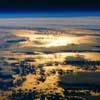|
Sunday:
August 4, 2002 | |
0001 GMT |
 |
Search for ancient Martian life continues
In the latest study of a 4.5 billion-year-old Martian meteorite, researchers have presented new evidence confirming that 25 percent of the magnetic material in the meteorite was produced by ancient bacteria on Mars. These latest results were published in the journal Applied and Environmental Microbiology.
 FULL STORY FULL STORY
 |  |

|
 |
Gregory confirmed to No. 2 post at NASA
The U.S. Senate late Thursday confirmed Frederick D. Gregory as NASA Deputy Administrator. Gregory, a veteran Space Shuttle commander who previously served as the Associate Administrator for Space Flight, is set to become the agency's first African-American deputy.
 FULL STORY FULL STORY
 |  |

|
 |
|
Saturday:
August 3, 2002 | |
0100 GMT |
 |
Astronomers feast on an interstellar hamburger
NASA's Hubble Space Telescope has snapped a photograph of a strange object that bears an uncanny resemblance to a hamburger. The object, nicknamed Gomez's Hamburger, is a sun-like star nearing the end of its life. It already has expelled large amounts of gas and dust and is on its way to becoming a colorful, glowing planetary nebula.
 FULL STORY FULL STORY
 |  |

|
 |
No bugs please, this is a clean planet!
When packing for a trip towards another planet, there are some things, such as microorganisms, that you do not want to include in your 'luggage'. For example, what if extraterrestial life is finally detected on Mars, and scientists realise afterwards that such life is actually terrestrial?
 FULL STORY FULL STORY
 |  |

|
 |
|
Friday:
August 2, 2002 | |
0233 GMT |
 |
Delta 4 rocket undergoes first cryogenic tanking test
Boeing technicians pumped super-cold liquid oxygen into both stages of the inaugural Delta 4 rocket for the first time early Thursday, completing the initial step in a series of fueling tests at Cape Canaveral's rebuilt launch pad 37B.
 FULL STORY FULL STORY
 ARCHIVED DELTA 4 COVERAGE ARCHIVED DELTA 4 COVERAGE
 |  |

|
 |
Major Atlas 5 launch readiness review completed
As Lockheed Martin's Atlas 5 rocket was passing a comprehensive engineering review this week, spacecraft teams were getting set to resume final pre-flight preparations on the French-built Hot Bird 6 satellite to be carried into space during the launcher's maiden voyage on August 21.
 FULL STORY FULL STORY
 ARCHIVED ATLAS 5 COVERAGE ARCHIVED ATLAS 5 COVERAGE
 |  |

|
 |

Video coverage for subscribers only:
 VIDEO: OVERVIEW PRESENTATION OF ATLAS 5 PROGRAM QT or RV VIDEO: OVERVIEW PRESENTATION OF ATLAS 5 PROGRAM QT or RV
 VIDEO: BRIEFING ON ATLAS 5 LAUNCH SITE QT or RV VIDEO: BRIEFING ON ATLAS 5 LAUNCH SITE QT or RV
 VIDEO: ATLAS 5 LAUNCH PROCESSING OVERVIEW QT or RV VIDEO: ATLAS 5 LAUNCH PROCESSING OVERVIEW QT or RV
 SUBSCRIBE NOW SUBSCRIBE NOW

|
Shuttle repair approved; next launch Sept. 28
As expected, NASA managers meeting Wednesday to review shuttle fuel line repair options tentatively agreed to implement a welding/polishing technique to fix tiny cracks in space shuttle fuel lines, sources say. They also agreed on a previously proposed launch sequence that would see shuttle flights resume on Sept. 28.
 FULL STORY FULL STORY
 |  |

|
 |
Giant black holes in collision
One of the more spectacular phenomena in the cosmos might just be the collision of supermassive black holes that accompanies the merger of galaxies. But the astronomical community has not had definitive proof that these black holes are actually coming together. For the first time, astronomers have now produced a convincing mathematical model that offers the strongest support to date for the idea that the black holes merge when their host galaxies do.
 FULL STORY FULL STORY
 |  |

|
 |
|
Thursday:
August 1, 2002 | |
0230 GMT |
 |
Atlas 5 launch rescheduled
Lockheed Martin has set August 21 as the new launch date for the inaugural Atlas 5 rocket. Liftoff from Cape Canaveral is set for 6:05 p.m. EDT (2205 GMT) at the opening of an 89-minute window. The launch was pushed back from August 12 due to delays getting the rocket's cargo -- the Eutelsat Hot Bird 6 satellite -- ready for the flight.
 ARCHIVED ATLAS 5 COVERAGE ARCHIVED ATLAS 5 COVERAGE
 |  |

|
 |

Video coverage for subscribers only:
 VIDEO: OVERVIEW PRESENTATION OF ATLAS 5 PROGRAM QT or RV VIDEO: OVERVIEW PRESENTATION OF ATLAS 5 PROGRAM QT or RV
 VIDEO: BRIEFING ON ATLAS 5 LAUNCH SITE QT or RV VIDEO: BRIEFING ON ATLAS 5 LAUNCH SITE QT or RV
 VIDEO: ATLAS 5 LAUNCH PROCESSING OVERVIEW QT or RV VIDEO: ATLAS 5 LAUNCH PROCESSING OVERVIEW QT or RV
 SUBSCRIBE NOW SUBSCRIBE NOW

|
'Rivers of gravity' found to define cosmic landscape
NASA's Chandra X-ray Observatory has discovered part of an intergalactic web of hot gas and dark matter that contains most of the material in the universe. The hot gas, which appears to lie like a fog in channels carved by rivers of gravity, has been hidden from view since the time galaxies formed.
 FULL STORY FULL STORY
 |  |

|
 |
Bedrest campaign ends
Long-duration spaceflight has a significant impact on the body, with astronauts experiencing changes in their bone and muscle in particular. To meet the requirements of long-stay missions aboard the International Space Station and prepare for future interplanetary missions, space agencies are working together to develop preventive-medicine methods or countermeasures intended to overcome the adverse effects of spaceflight.
 FULL STORY FULL STORY
 |  |

|
 |
|
Wednesday:
July 31, 2002 | |
0401 GMT |
 |
Cosmic rays said linked to global warming
Researchers studying global warming have often been confounded by the differences between observed increases in surface-level temperatures and unchanging low-atmosphere temperatures. A theory has been proposed that changes in cloud cover could help explain the puzzling phenomenon, but no one -- until now -- has come up with an argument that could account for the varying heat profiles.
 FULL STORY FULL STORY
 |  |

|
 |
NASA-developed alloy has Earthly potentials
A new high-strength aluminum-silicon alloy developed at NASA's Marshall Space Flight Center, Huntsville, Ala., promises to lower engine emissions and could improve gas mileage in cars, boats and recreational vehicles. The new alloy, co-invented by Jonathan Lee, a NASA structural materials engineer, was originally developed for the automotive industry.
 FULL STORY FULL STORY
 |  |

|
 |
|
Tuesday:
July 30, 2002 | |
0226 GMT |
 |
Cosmic thermostats provide clue to astronomy puzzle
A cosmic phenomenon involving pockets of hot gas in space which appear not to cool down has been puzzling astronomers for three decades. Now new research shows that the energy of the hot gas is actually replenished by jets emitted by black holes.
 FULL STORY FULL STORY
 |  |

|
 |
First evidence for early bombardment of Earth
University of Queensland researchers have for the first time discovered terrestrial evidence of a meteorite bombardment nearly 4 billion years ago. It is widely accepted that the moon was heavily bombarded at this time, creating huge craters and basins. But although the effect of these impacts is still clearly visible on the moon today, movement of Earth's dynamic plates over geological time have reshaped the terrestrial surface dramatically, leaving little evidence of these catastrophic events.
 FULL STORY FULL STORY
 |  |

|
 |
Station crew completes microcapsule experiment
The Expedition Five crew of the International Space Station has successfully completed a manufacturing experiment to create microcapsules that could aid the development of an improved drug delivery method in the body.
 FULL STORY FULL STORY
 |  |

|
 |
|
Monday:
July 29, 2002 | |
0200 GMT |
 |
Lasers may 'shine' spacecraft data to Earth
Lasers and telescopes could replace radio transmitters on satellites in ten years, suggests a paper in the current issue of Science. They'd fix a worsening bottleneck in getting data back from satellites and spacecraft, say authors of a new study.
 FULL STORY FULL STORY
 |  |

|
 |


 This exceptional chronicle of the historic Apollo 11 lunar landing mission features new digital transfers of film and television coverage unmatched by any other.
This exceptional chronicle of the historic Apollo 11 lunar landing mission features new digital transfers of film and television coverage unmatched by any other.
 Apollo 11 - The NASA Mission Reports Vol. 3 is the first comprehensive study of man's first mission to another world is revealed in all of its startling complexity. Includes DVD!
Apollo 11 - The NASA Mission Reports Vol. 3 is the first comprehensive study of man's first mission to another world is revealed in all of its startling complexity. Includes DVD!